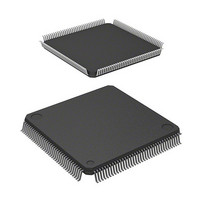R5F61665N50FPV Renesas Electronics America, R5F61665N50FPV Datasheet - Page 482

R5F61665N50FPV
Manufacturer Part Number
R5F61665N50FPV
Description
MCU FLASH 512K ROM 144-LQFP
Manufacturer
Renesas Electronics America
Series
H8® H8SX/1600r
Datasheet
1.R5F61665N50FPV.pdf
(1492 pages)
Specifications of R5F61665N50FPV
Core Processor
H8SX
Core Size
16/32-Bit
Speed
50MHz
Connectivity
EBI/EMI, I²C, IrDA, SCI, SmartCard, USB
Peripherals
DMA, LVD, POR, PWM, WDT
Number Of I /o
92
Program Memory Size
512KB (512K x 8)
Program Memory Type
FLASH
Ram Size
40K x 8
Voltage - Supply (vcc/vdd)
3 V ~ 3.6 V
Data Converters
A/D 8x10b; D/A 2x8b
Oscillator Type
External
Operating Temperature
-20°C ~ 75°C
Package / Case
144-LQFP
Lead Free Status / RoHS Status
Lead free / RoHS Compliant
Eeprom Size
-
Available stocks
Company
Part Number
Manufacturer
Quantity
Price
Company:
Part Number:
R5F61665N50FPV
Manufacturer:
Renesas Electronics America
Quantity:
10 000
- Current page: 482 of 1492
- Download datasheet (8Mb)
Section 10 DMA Controller (DMAC)
10.9
1. DMAC Register Access During Operation
2. Settings of Module Stop Function
3. Activation by DREQ Falling Edge
4. Acceptation of Activation Source
Rev. 2.00 Oct. 21, 2009 Page 448 of 1454
REJ09B0498-0200
Except for clearing the DTE bit in DMDR, the settings for channels being transferred
(including waiting state) must not be changed. The register settings must be changed during
the transfer prohibited state.
The DMAC operation can be enabled or disabled by the module stop control register. The
DMAC is enabled by the initial value.
Setting bit MSTPA13 in MSTPCRA stops the clock supplied to the DMAC and the DMAC
enters the module stop state. However, when a transfer for a channel is enabled or when an
interrupt is being requested, bit MSTPA13 cannot be set to 1. Clear the DTE bit to 0, clear the
DTIF or DTIE bit in DMDR to 0, and then set bit MSTPA13.
When the clock is stopped, the DMAC registers cannot be accessed. However, the following
register settings are valid in the module stop state. Disable them before entering the module
stop state, if necessary.
⎯ TENDE bit in DMDR is 1 (the TEND signal output enabled)
⎯ DACKE bit in DMDR is 1 (the DACK signal output enabled)
The DREQ falling edge detection is synchronized with the DMAC internal operation.
A. Activation request waiting state: Waiting for detecting the DREQ low level. A transition to
B. Transfer waiting state: Waiting for a DMAC transfer. A transition to 3. is made.
C. Transfer prohibited state: Waiting for detecting the DREQ high level. A transition to 1. is
After a DMAC transfer enabled, a transition to 1. is made. Therefore, the DREQ signal is
sampled by low level detection at the first activation after a DMAC transfer enabled.
At the beginning of an activation source reception, a low level is detected regardless of the
setting of DREQ falling edge or low level detection. Therefore, if the DREQ signal is driven
low before setting DMDR, the low level is received as a transfer request.
When the DMAC is activated, clear the DREQ signal of the previous transfer.
2. is made.
made.
Usage Notes
Related parts for R5F61665N50FPV
Image
Part Number
Description
Manufacturer
Datasheet
Request
R

Part Number:
Description:
KIT STARTER FOR M16C/29
Manufacturer:
Renesas Electronics America
Datasheet:

Part Number:
Description:
KIT STARTER FOR R8C/2D
Manufacturer:
Renesas Electronics America
Datasheet:

Part Number:
Description:
R0K33062P STARTER KIT
Manufacturer:
Renesas Electronics America
Datasheet:

Part Number:
Description:
KIT STARTER FOR R8C/23 E8A
Manufacturer:
Renesas Electronics America
Datasheet:

Part Number:
Description:
KIT STARTER FOR R8C/25
Manufacturer:
Renesas Electronics America
Datasheet:

Part Number:
Description:
KIT STARTER H8S2456 SHARPE DSPLY
Manufacturer:
Renesas Electronics America
Datasheet:

Part Number:
Description:
KIT STARTER FOR R8C38C
Manufacturer:
Renesas Electronics America
Datasheet:

Part Number:
Description:
KIT STARTER FOR R8C35C
Manufacturer:
Renesas Electronics America
Datasheet:

Part Number:
Description:
KIT STARTER FOR R8CL3AC+LCD APPS
Manufacturer:
Renesas Electronics America
Datasheet:

Part Number:
Description:
KIT STARTER FOR RX610
Manufacturer:
Renesas Electronics America
Datasheet:

Part Number:
Description:
KIT STARTER FOR R32C/118
Manufacturer:
Renesas Electronics America
Datasheet:

Part Number:
Description:
KIT DEV RSK-R8C/26-29
Manufacturer:
Renesas Electronics America
Datasheet:

Part Number:
Description:
KIT STARTER FOR SH7124
Manufacturer:
Renesas Electronics America
Datasheet:

Part Number:
Description:
KIT STARTER FOR H8SX/1622
Manufacturer:
Renesas Electronics America
Datasheet:

Part Number:
Description:
KIT DEV FOR SH7203
Manufacturer:
Renesas Electronics America
Datasheet:











